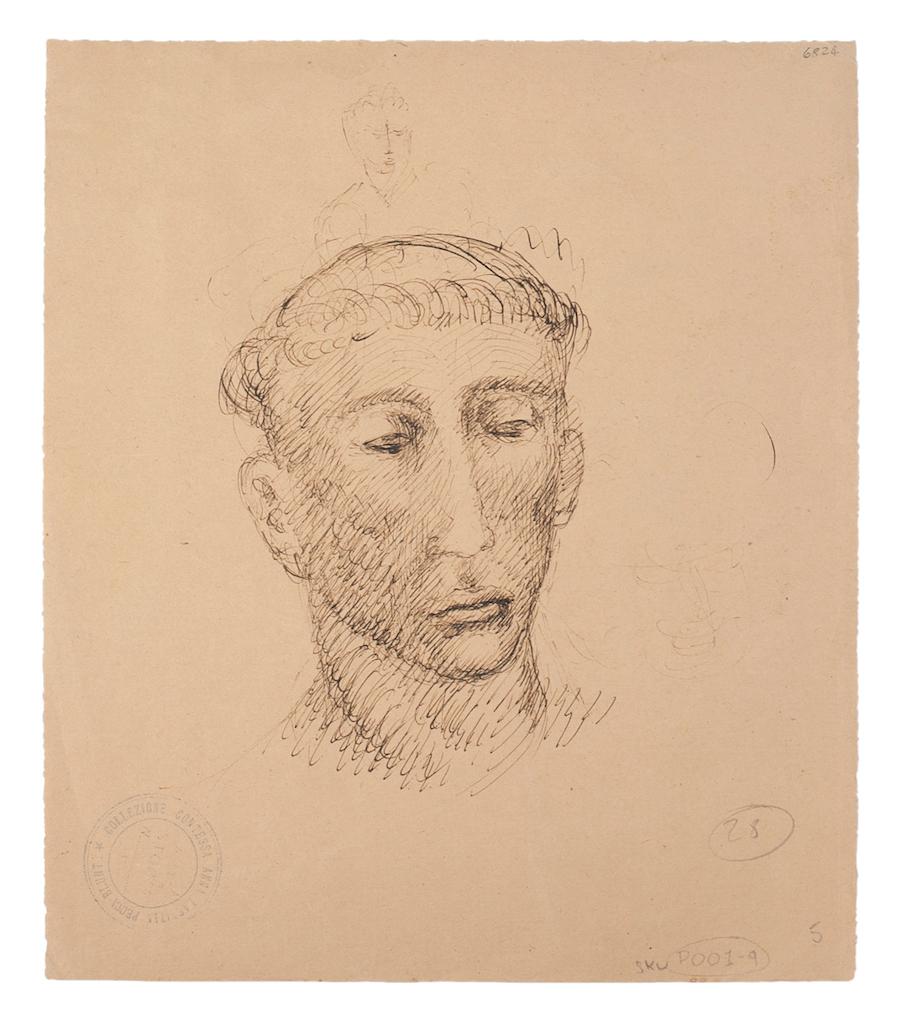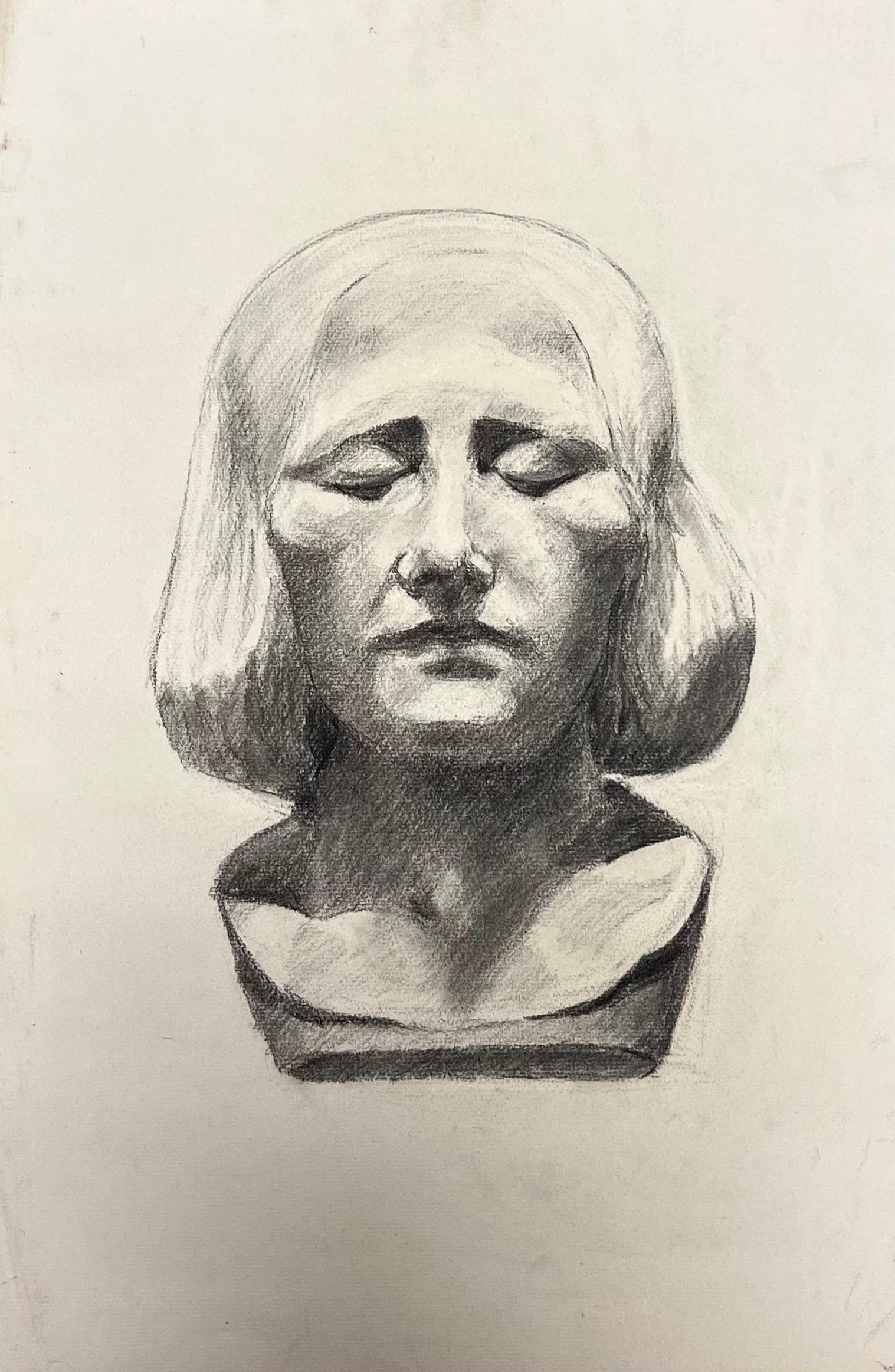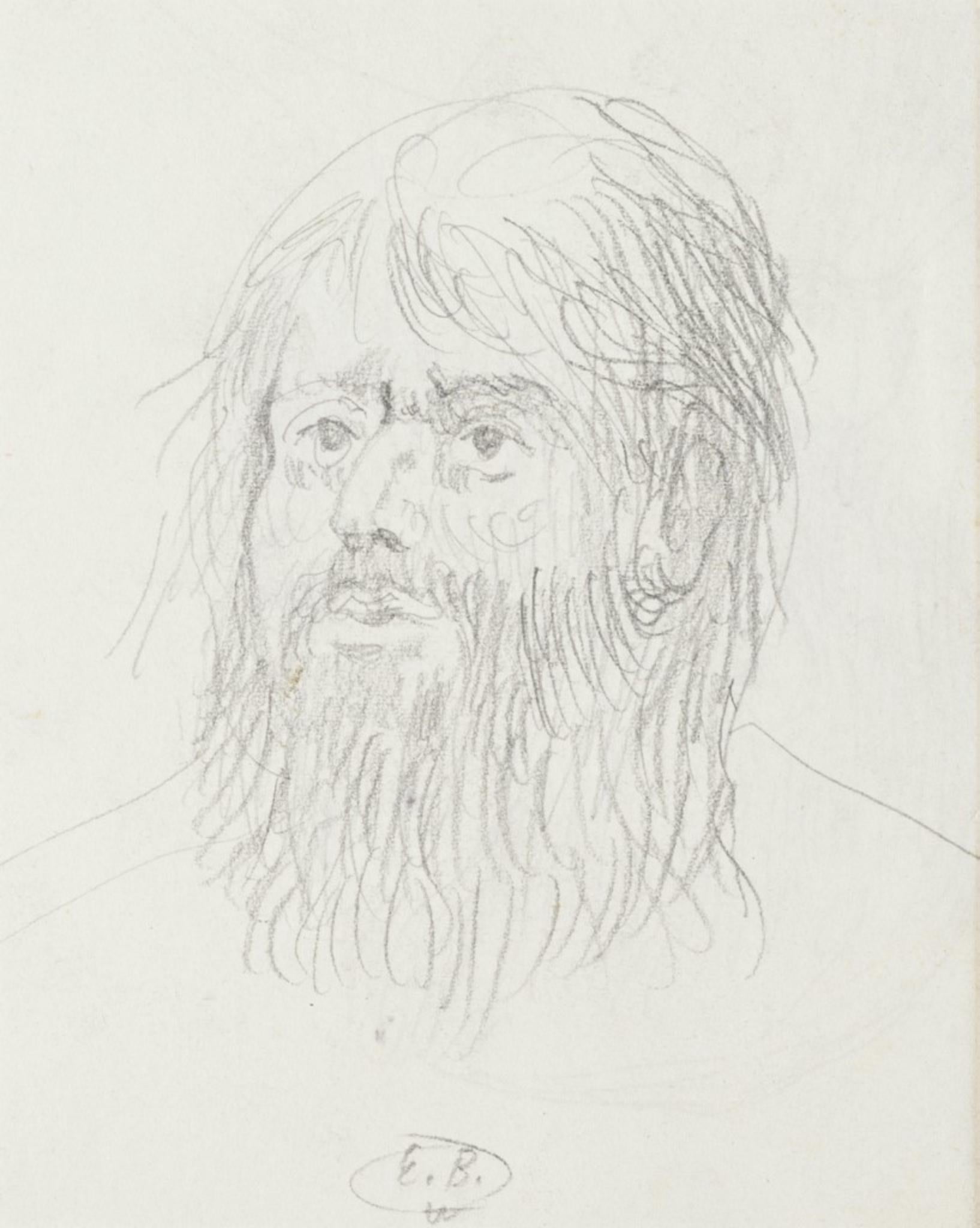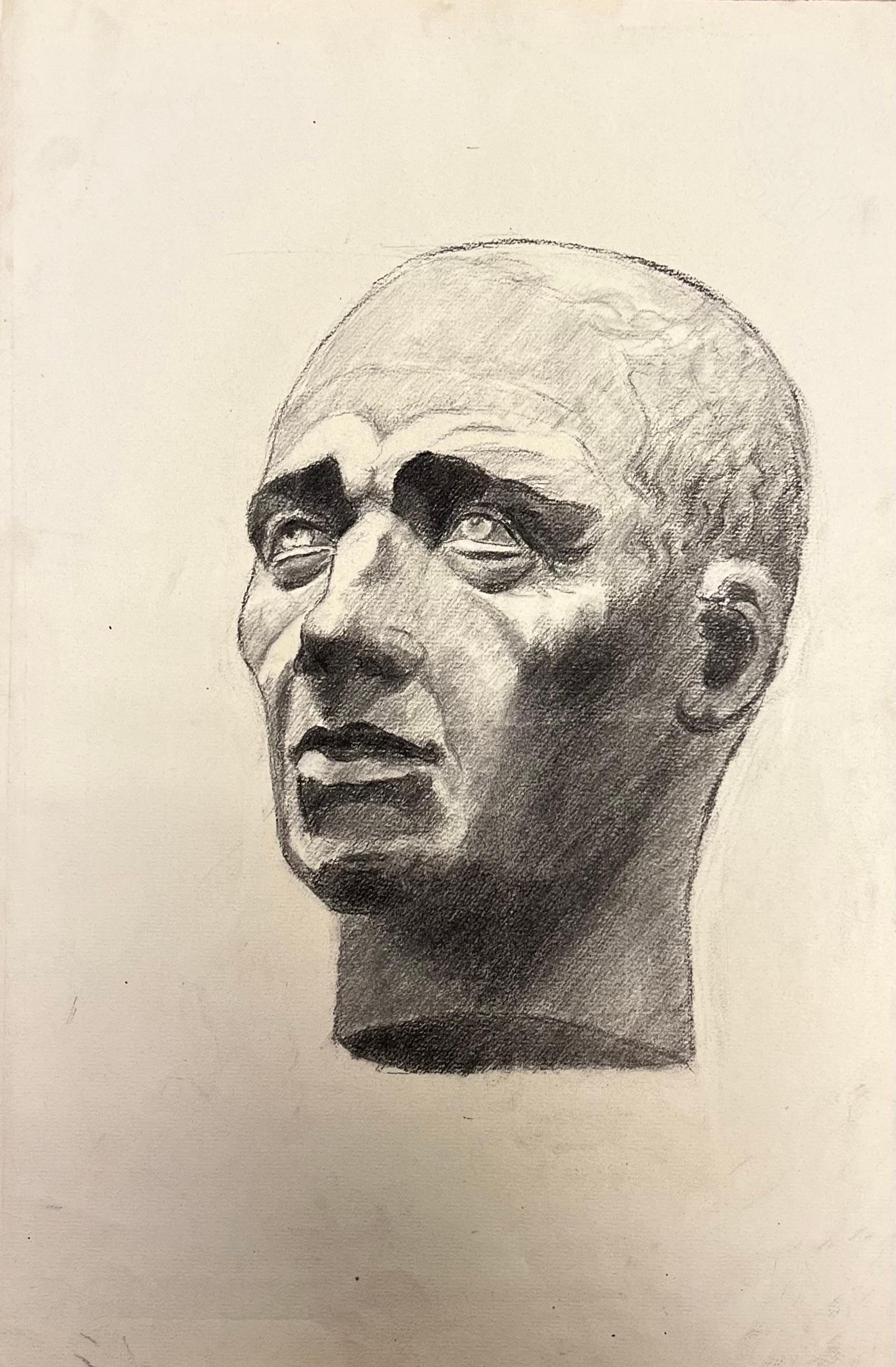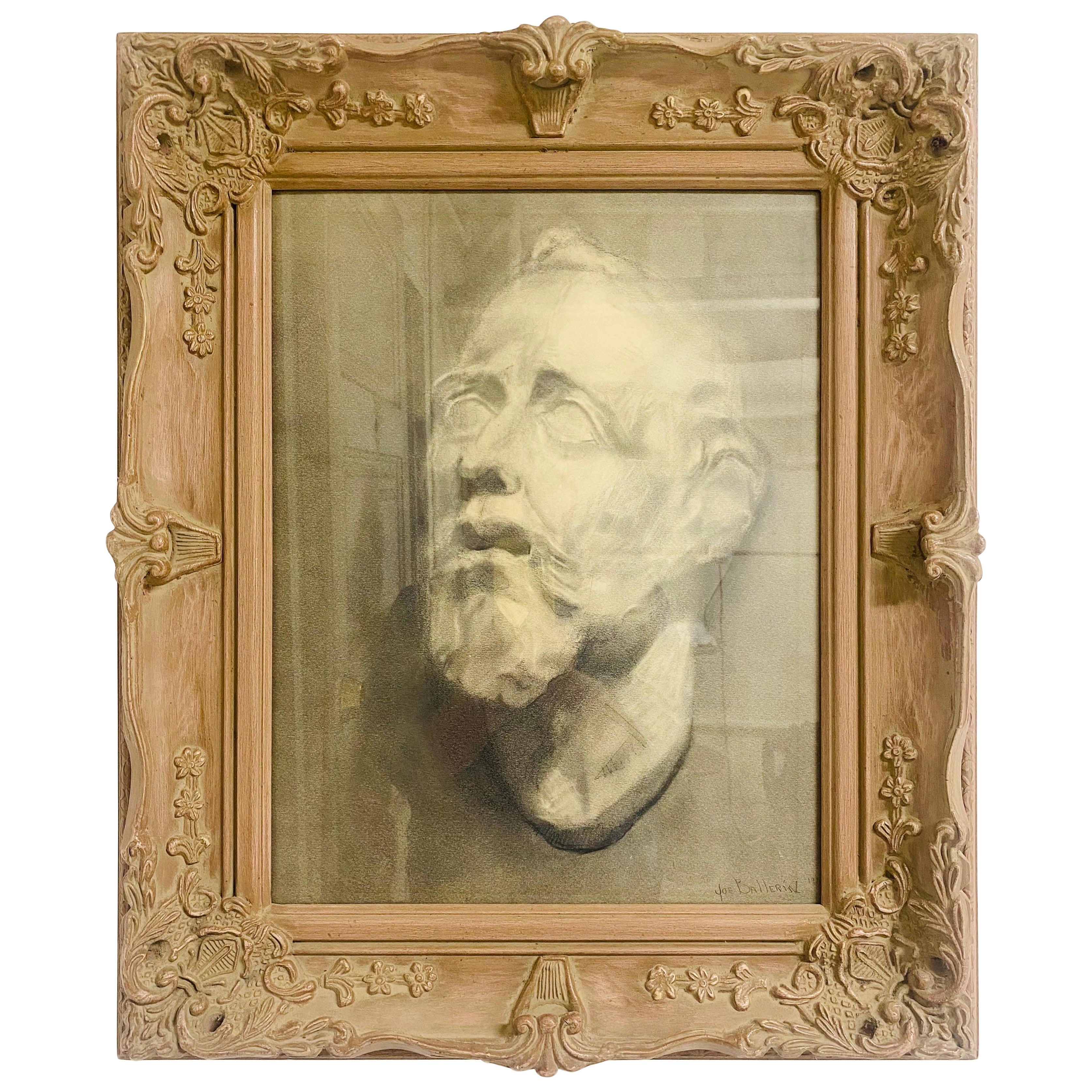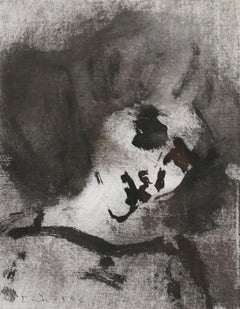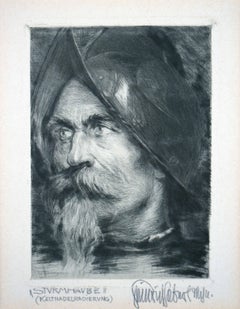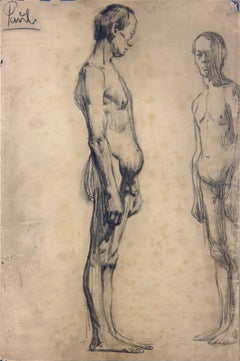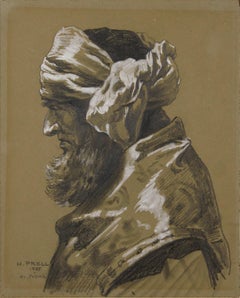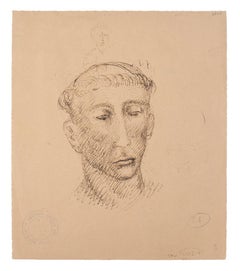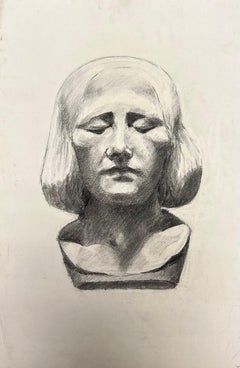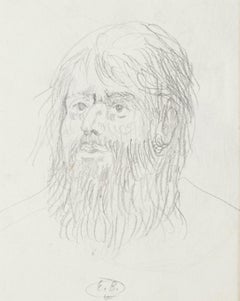Items Similar to Sketch of a head - Carved in stone -
Want more images or videos?
Request additional images or videos from the seller
1 of 8
Emil FaeschSketch of a head - Carved in stone -1888
1888
$431.18
$538.9820% Off
£319.94
£399.9320% Off
€360
€45020% Off
CA$602.21
CA$752.7720% Off
A$653.12
A$816.3920% Off
CHF 343.04
CHF 428.8020% Off
MX$7,933.20
MX$9,916.5020% Off
NOK 4,292.62
NOK 5,365.7720% Off
SEK 4,041.74
SEK 5,052.1720% Off
DKK 2,742.57
DKK 3,428.2120% Off
About the Item
Emil Faesch (1865 Basel - 1915 Basel). Sketch of a head. Charcoal on painting cardboard, 60 x 47.5 cm (folio size), signed and dated at lower right "E. Faesch. 1888.".
Minor browning.
- Carved in stone -
About the artwork
The life-size head has an immensely present presence. This effect is due to the fact that Faesch took his cue from academic classical busts, but made the head naturalistic, right down to the eyelashes and the folds of the eyelids, thus breaking through the distance of classical ideality and creating an immediacy. Paradoxically, the liveliness thus achieved culminates in the fact that the sitter appears to have exhaled the breath of life. The present presence is thus transferred back to the eternity of the stone, in whose specific materiality the face and especially the hair shimmer, while the upper part of the body clearly exposes the stone.
The architect Emil Faesch, who was initially trained as a draughtsman and modeller and would continue to practise this profession as a teacher at the Gewerbeschule Basel, has here created an impressive reinterpretation of the academic study head, into which he breathes new life, while at the same time surrounding it with the breath of death.
About the artist
Emil Faesch was a member of the famous Faesch family of Basel goldsmiths. At an early age, the artistically gifted Faesch attended the Basel School of Drawing and Modelling, where he studied under Fritz Schider. After an apprenticeship at the architectural firm of Vischer & Fürter, he continued his training as an architect by studying at the Technical University of Munich under August and Friedrich Thiersch. In 1892 he was appointed curator at the Gewerbemuseum in Basel. From 1893 he taught at the associated Gewerbeschule. In 1897 he resigned to work as a freelance architect.
Faesch built many public buildings that shaped the cityscape, as well as bridges. These include the prominent Mittlere Rheinbrücke in Basel.
Selected bibliography
Saur, Allgemeines Künstlerlexikon. Die bildenden Künstler aller Zeiten und Völker, vol. 36, p. 192.
GERMAN VERSION
Emil Faesch (1865 Basel - 1915 Basel). Studienkopf. Kohle auf Malkarton, 60 x 47,5 cm (Blattmaß), rechts unten signiert und datiert „E. Faesch. 1888.“.
Minimal braunfleckig.
- In Stein gemeißelt -
zum Werk
Der lebensgroße Kopf entfaltet eine ungemein gegenwärtige Präsenz. Diese Wirkung resultiert daraus, dass sich Faesch an akademisch-klassizistischen Büsten orientiert, den Kopf jedoch bis in die Wimpern und die Augenliedfalten hinein naturalistisch ausformt, wodurch die Distanz der klassizistischen Idealität auf eine Unmittelbarkeit hin durchbrochen wird. Die damit erzielte Lebendigkeit kulminiert paradoxerweise gerade darin, dass der Dargestellte offensichtlich den Lebensatem ausgehaucht hat. Dadurch wird die gegenwärtige Präsenz wieder in die Ewigkeit des Steins überführt, in dessen spezifischer Materialität das Antlitz und insbesondere des Haare aufschimmern, während der Oberkörper den Stein deutlich ausstellt.
Der zunächst als Zeichner und Modellierer ausgebildete Architekt Emil Faesch, den dieses Metier im Rahmen seiner Tätigkeit als Lehrer der Gewerbeschule Basel auch weiterhin beschäftigen sollte, hat hier eine beeindruckende Neuinterpretation des akademischen Studienkopfes geschaffen, dem er neues Lebens einhaucht, wodurch ihn zugleich der Hauch des Todes umgibt.
zum Künstler
Emil Faesch entstammt der berühmten Basler Goldschmiede-Familie Faesch. Bereits in jungen Jahren besucht der künstlerisch begabte Faesch die Basler Zeichen- und Modellierschule, wo er bei Fritz Schider lernt. Nach einer Lehre im Architekturbüro Vischer & Fuerter, setzt er seine Ausbildung als Architekt mit einem Studium an der TH München bei August und Friedrich Thiersch fort. 1892 erfolgt eine Berufung als Konservator an das Basler Gewerbemuseum. Ab 1893 unterrichtet er an der angegliederten Gewerbeschule. 1897 tritt er von seinen Ämter zurück, um sich fortan als freier Architekt zu betätigen.
Faesch errichte zahlreiche das Stadtbild prägende öffentlichen Gebäude, aber auch Brückenbauten. Darunter die prominente Mittlere Rheinbrücke in Basel.
Auswahlbibliographie
Saur allgemeines Künstlerlexikon. Die bildenden Künstler aller Zeiten und Völker, Bd. 36, S. 192.
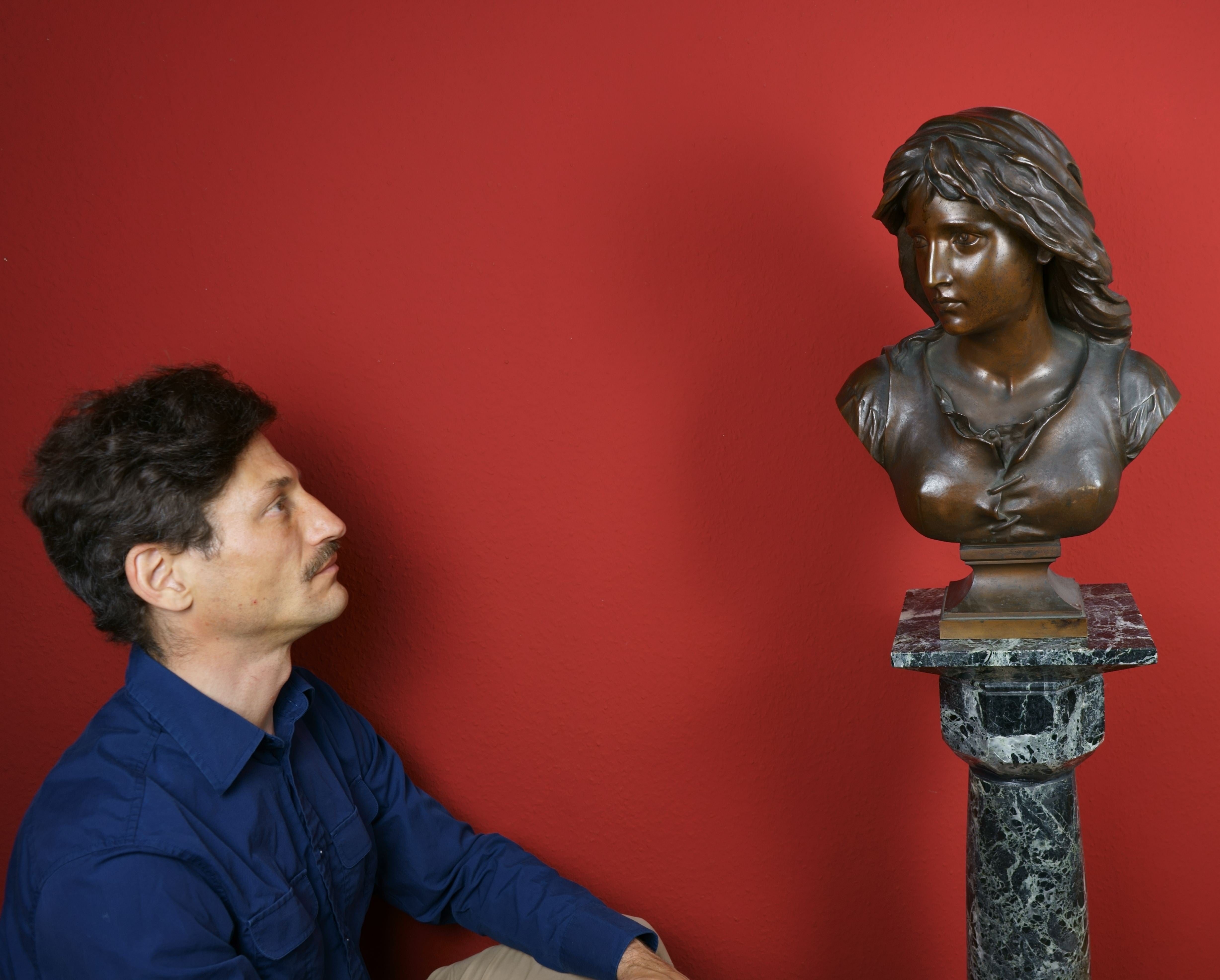
About the Seller
5.0
Vetted Professional Seller
Every seller passes strict standards for authenticity and reliability
Established in 2014
1stDibs seller since 2023
21 sales on 1stDibs
- ShippingRetrieving quote...Shipping from: Berlin, Germany
- Return Policy
Authenticity Guarantee
In the unlikely event there’s an issue with an item’s authenticity, contact us within 1 year for a full refund. DetailsMoney-Back Guarantee
If your item is not as described, is damaged in transit, or does not arrive, contact us within 7 days for a full refund. Details24-Hour Cancellation
You have a 24-hour grace period in which to reconsider your purchase, with no questions asked.Vetted Professional Sellers
Our world-class sellers must adhere to strict standards for service and quality, maintaining the integrity of our listings.Price-Match Guarantee
If you find that a seller listed the same item for a lower price elsewhere, we’ll match it.Trusted Global Delivery
Our best-in-class carrier network provides specialized shipping options worldwide, including custom delivery.More From This Seller
View AllWoman's head / - Female Wisdom -
Located in Berlin, DE
Emil Wachter (1921 Neuburgweiser - 2012 Karlsruhe), Woman's head, 1986. Drawing in ink on canvas, 24.5 cm x 19 cm (sheet size), 44.5 cm x 36.4 cm (frame), signed ‘E. Wa[achter]’ lowe...
Category
1980s Realist Figurative Drawings and Watercolors
Materials
Paper
Balaclava - The target in sight -
Located in Berlin, DE
Heinrich Haberl (1869 Passau to 1934 Munich), Sturmhaube, c. 1900. drypoint, 14 x 10 cm (platemark), 28 x 21 cm (sheet size), 39 x 29 cm (passe-partout), titled "Sturmhaube" in lead at lower left and inscribed "Kaltnadelradierung", signed and locally inscribed "Heinrich Haberl Mchn. [Munich]" at lower right, inscribed again in lead on verso and with old collection stamp.
- slightly darkened, fixed and mounted
- The target in sight -
About the artwork
The theatrical "role-portrait" is to be seen against the background of the Rembrandt cult, which reached its climax at the end of the 19th century. The soldier seems to have stepped straight out of Rembrandt's Night Watch (1642) to fix something outside the picture with an alert and ready gaze. The steeply rising brim of the morion frames the gaze and thus perspectivises it as the actual 'pictorial action'. The gaze represents both the vigilant defence and the visionary goal of the battle.
Not only the subject, but also the style of the etching needle reflect Rembrandt's understanding of the times. Strong contrasts of light and dark are created in a virtuoso free stroke, without losing the effect of the reflections on the helmet and in the eyes. This shows a kinship with the early prints of Lovis Corinth, who also saw himself as an artist in the role of the knight. Against this background, Haberl's picture can also be seen as a representation of his artistic self-image.
About the artist
Heinrich Haberl first attended the art school in Nuremberg and from 1892 studied at the Munich Academy. There he was a master student of Johann Leonhard von Raab, Rudolf von Seitz, Franz von Defregger...
Category
Early 19th Century Realist Figurative Prints
Materials
Etching
$229 Sale Price
20% Off
Self-portrait - Homo nudus -
Located in Berlin, DE
Bruno Paul (1874 Seifhennersdorf - 1968 Berlin). Self-portrait, c. 1895. Pencil on paper, mounted on cardboard, 53.5 x 35 cm, signed 'Paul' at upper left.
- Homo nudus -
About the artwork
In a mirrored situation, Bruno Paul looks at himself in the picture. While his body, which is the size of the format, is shown in profile parallel to the picture, he turns his head into the picture in order to become aware of himself there, whereby the lighter use...
Category
1890s Realist Figurative Drawings and Watercolors
Materials
Pencil
$3,353 Sale Price
20% Off
Half-length portrait of a Pharisee - In the shadow of betrayal -
Located in Berlin, DE
Hermann Prell (1854 Leipzig - 1922 Dresden-Loschwitz). Half-length portrait of a Pharisee, 1885. Sketch for the right-hand figure in the painting Judas Iscariot, 1886. Pencil drawing heightened with opaque white and black chalk on beige-grey wove paper (papier vélin), 34 x 27.8 cm (visible size), 52 x 45 cm (mount), signed, dated and inscribed "H. PRELL 1885 zu 'Judas'".
Minor browning, collection stamp on the reverse.
- In the shadow of betrayal -
About the artwork
This painting is the sketch for the head of the Pharisee offering the coins to Judas in one of Herrmann Prell's major works, the painting Betrayal of Judas, completed in 1886. The painting belongs to the Staatliche Kunstsammlungen Dresden and is illustrated in Adolf Rosenberg: Prell, Bielefeld and Leipzig 1901, p. 21 (Fig. 19). It is especially highlighted in Thieme-Becker (vol. 27, p. 376).
Hermann Prell, Betrayal of Judas, 1886
The monumental head, which fills the picture and is distinguished by its ornamented robe, is almost a lost profile, which in the executed painting is justified by the Pharisee's turning towards Judas. Despite the fact that the sitter withdraws from the viewer by turning away, it was necessary to artistically elaborate the motivation for the purchase of one of Christ's disciples, which is why the drawing focuses on the expression of the face, while the 'accessories' are treated in a more summary manner.
In characterising the face, Hermann Prell performs a balancing act: since the Pharisee, despite his destructive actions, is an actor in the history of salvation, the head must show a dignity appropriate to the event, but at the same time the physiognomy must also bear witness to the scheming attitude that led to the betrayal. To solve this dilemma, Prell draws on the traditional depictions of the heads of the apostles, shading the face to indicate the obdurate darkness of the spirit and moving the base of the nose slightly upwards while the mouth falls away, thus giving a physiognomic expression to the motivation of the action. The fatal drama of the betrayal is expressed in the monumentalisation of the head and in the thunderous white highlights that contrast with the darkness of the chalk.
As a study, considered by the artist to be a work in itself, this drawing reveals the pictorial problems and brainstorming of monumental painting.
About the artist
In 1872 Prell, who was one of the most important exponents of monumental painting of his time, began studying painting with Theodor Grosse at the Dresden Academy of Art and continued with Carl Gussow at the Berlin Academy in 1876. Hans von Marées taught him in Rome in 1878. More influential on his work, however, were Arnold Böcklin and Max Klinger, with whom Prell had been friends since his student days and with whom he worked together on several occasions.
Prell's first major work, which established his reputation as a monumental painter, were the frescoes in the banqueting hall of the Architektenhaus in Berlin in 1881/82, commissioned by the state and depicting the different periods of architecture. Prell then went to Italy for two years to study fresco painting. Other major commissions followed. These included monumental frescoes in the town halls of Worms (1884), Hildesheim (1882-92), Gdansk (1895) and Dresden, the staircase of the Silesian Museum of Fine Arts in Breslau (1893/94), the throne room of the German Embassy in Rome (1896-99) and the staircase of the Albertinum in Dresden (1900-1904).
From 1886 Prell taught at the academy of arts in Berlin and in 1892 he was appointed professor at the academy of arts in Dresden. His students included Osmar Schindler and Hans Unger...
Category
1880s Realist Figurative Drawings and Watercolors
Materials
Chalk
$1,437 Sale Price
20% Off
Rebekka / - Rebekka's Appearance -
Located in Berlin, DE
Emil Wachter (1921 Neuburgweiser - 2012 Karlsruhe), Rebekka, 1987. Watercolor mounted on cardboard, 13.5 (height) x 14 cm (width). Signed “E.[mil] Wa[chter]” in pencil within the ima...
Category
1980s Realist Figurative Drawings and Watercolors
Materials
Paper
Lying Boy / - Fragile childlikeness -
Located in Berlin, DE
Alfred Fuchs (1925 Saarbrücken - 2003 Prague), Lying Boy. Charcoal drawing on strong paper, 30 x 41.5 cm, signed A.[lfred] Fuchs and dated [19]96.
- smal...
Category
1990s Realist Figurative Drawings and Watercolors
Materials
Charcoal
$527 Sale Price
20% Off
You May Also Like
Head of Man - Original Pen and Pencil on Paper by Marcello Ciampolini - 1946
Located in Roma, IT
Head of Man is an original modern drawing in pen and pencil on paper realized in 1946 by Italian artist Marcello Ciampolini.
Hand-signed on the lower left.
With the blue stamp of "...
Category
1940s Modern Figurative Drawings and Watercolors
Materials
Pen, Pencil
Mid Century French Pencil Drawing of a Peaceful Stone Female Head
By Josine Vignon
Located in Cirencester, Gloucestershire
Title: Mid Century French Study
Artist: Josine Vignon (French 1922-2022)
Medium: Pencil/ charcoal on artists paper
Size: 19 (height) x 12.5 (width)
Stamped: Verso
Condition: Goo...
Category
Mid-20th Century Post-Impressionist Figurative Paintings
Materials
Charcoal, Pencil
$153 Sale Price
20% Off
Head of Man - Pencil Drawing by Eugène Berman - 1950s
Located in Roma, IT
Man Head is an original monogramm drawing in pencil, realized by Russian scenographer Eugène Berman, hand-signed.
Image Dimension: 35 x 25 cm
Image Dimensions: 15 x 12 cm
In very g...
Category
1950s Modern Figurative Drawings and Watercolors
Materials
Pencil
Mid Century French Drawing of a Classical Bald Male Bust
By Josine Vignon
Located in Cirencester, Gloucestershire
Title: Mid Century French Male Bust
Artist: Josine Vignon (French 1922-2022)
Medium: Pencil/ charcoal on artists paper
Size: 19 (height) x 12.5 (width)
Stamped: Verso
Condition:...
Category
Mid-20th Century Post-Impressionist Figurative Paintings
Materials
Charcoal, Pencil
$142 Sale Price
20% Off
Early 20th century artist study of a classical bust pencil on paper
Located in Allentown, PA
This is an early 20th century pencil drawing of a classical bust. This drawing is presented in a hand carved vintage French cocoa inspired frame. This pencil drawing is an artist stu...
Category
Early 20th Century American Classical Roman Drawings
Materials
Paper
Life Size Sculpture of Male Head in Terracotta Clay "Andrea"
By William J Rushton
Located in New York, NY
Terracotta life-size male head.
Rushton sculpts all of his busts using live models over the course of multiple sittings. While realistic and classical in character, his sculptures ...
Category
2010s Realist Figurative Sculptures
Materials
Clay, Terracotta
More Ways To Browse
Antique Sketch
Antique Carved Head
Stone Head
Antique Stone Head
Chalk Head
Vogue Illustration
Italian Charcoal Drawing
17th Ink Drawings
Dome Of The Rock
German Expressionists Drawings
India Watercolour 19th Century
Muybridge Horse
Pencil Drawing Church
The Scarecrow
Bust Drawing
Drawing In Sanguine
Italian Watercolor Artist
Matisse Watercolour
